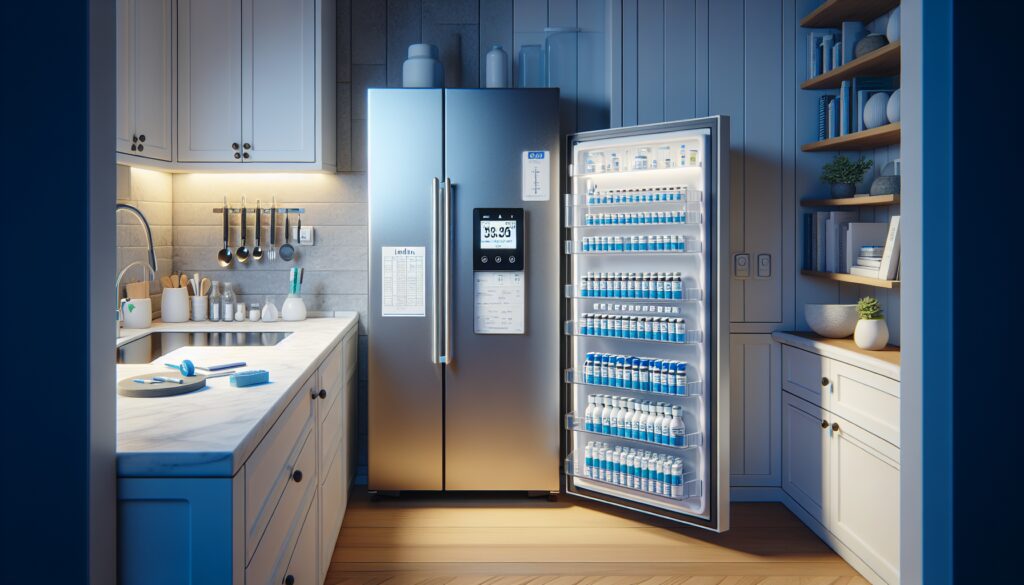
Understanding the safe storage of insulin is crucial for anyone managing diabetes. The effectiveness of insulin can be significantly impacted by how it is stored, making it essential to follow proper guidelines to ensure its stability and potency.
Storing your insulin correctly can help prevent unnecessary complications in your diabetes management. Read on for essential tips to keep your insulin safe and fully effective.
🔍 Seeking a breakthrough in Type 2 Diabetes management?
Discover our expert insights and innovative approaches on ‘How to Cure Diabetes’.
Click to transform your health journey today!
What you\'ll find in this article?
- How to store unopened insulin
- How to store opened insulin vials, pens, and cartridges
- What are the guidelines for insulin storage and handling?
- Tips for checking insulin before using it
- Protecting your insulin vials during travel
- Proper disposal of insulin syringes and pump components
- Questions related to maintaining insulin integrity
How to store unopened insulin
Unopened insulin should always be kept in the refrigerator, ideally at a temperature between 36°F and 46°F (2°C to 8°C). Avoid placing it in the freezer or near the cooling element where it can freeze, as frozen insulin loses its efficacy and should not be used.
Always check the expiration date on the insulin package before use. Expired insulin can be less effective and should be replaced. Proper handling of insulin syringes is equally important; they should be kept sealed until use to maintain sterility.
For those using insulin pumps, ensure that the insulin used is stored according to manufacturer's guidelines as the reservoir or cartridge form may have different storage requirements.
Explore our specialized services in diabetes care 🌟.
From personalized diet plans to effective exercise routines, we have what you need to take control of Type 2 Diabetes.
Visit our services page now!









How to store opened insulin vials, pens, and cartridges
Once insulin is opened, it may be kept at room temperature to reduce injection discomfort. The room temperature should not exceed 86°F (30°C), and the insulin must be discarded after 28 days, even if there is some left in the vial or pen.
Keep opened insulin away from direct sunlight and heat sources, as these can degrade the insulin much faster. Store insulin safely by keeping it in a cool, dry place when not in use.
Mark the date of first use on the insulin vial or pen with a marker to help remember when it's time to discard it. This practice helps maintain insulin effectiveness and ensures you're using insulin within its optimal potency period.
What are the guidelines for insulin storage and handling?
Insulin storage recommendations are provided by healthcare professionals to help maintain the drug's stability. Insulin should not be exposed to extreme temperatures, and when refrigerated, it should be kept away from the freezer compartment.
Insulin vials and pens should be handled with clean hands to prevent contamination. Best practices for insulin storage also include avoiding shaking the vials, which can create air bubbles and affect the insulin dose.
Insulin types vary, and some may have specific storage guidelines. Consult with a healthcare provider or pharmacist about the storage requirements for your particular insulin type.
Tips for checking insulin before using it
Before each injection, inspect the insulin for any changes in appearance. If insulin is cloudy, has particles, or has changed color, it should not be used.
Mixtures of insulin, such as NPH, need gentle rolling between the hands to redistribute particles evenly. Do not shake the insulin vigorously as it can create froth and air bubbles.
Always ensure the insulin syringe is clean and clear of blockages before drawing up your dose. A proper draw ensures the accuracy of your insulin dose and effectiveness in your diabetes management.
Protecting your insulin vials during travel
When traveling, keep your insulin in a cool bag, avoiding direct exposure to sunlight or heat. Insulin should never be left in a car where temperatures can fluctuate widely.
If flying, carry insulin in your hand luggage since the cargo hold can become cold enough to freeze the insulin. Security regulations typically allow passengers with diabetes to carry insulin and syringes onboard.
Pack a letter from your healthcare provider detailing your diabetes treatment and need for insulin to facilitate airport security checks. Keeping your insulin safe while on the move helps ensure that your diabetes management remains uninterrupted.
Proper disposal of insulin syringes and pump components
Used insulin syringes and pump components should be disposed of in a sharps container to prevent needle injuries and infections. These containers are specifically designed for medical sharps and can often be obtained from pharmacies or healthcare providers.
When the sharps container is full, follow your local regulations for disposal. It might involve returning it to a pharmacy or a designated sharps disposal facility.
Never dispose of loose syringes in household trash or recycling bins as this poses a significant risk to others. Proper syringe disposal is an integral part of diabetes management and public safety.
For further guidance, watch this informative video on safe insulin storage techniques:
What is the proper way to store insulin?
The proper way to store insulin includes keeping unopened vials in the refrigerator and opened insulin at room temperature, away from light and heat. Always follow the manufacturer's insulin storage recommendations.
Remember that each type of insulin may have specific storage instructions, and it's important to adhere to those to maintain insulin's effectiveness.
Is insulin safe if not refrigerated?
Opened insulin is safe if not refrigerated, provided it is kept under 86°F (30°C) and used within 28 days. Unopened insulin, however, should always be refrigerated to ensure that it remains effective until its expiration date.
What are the guidelines for insulin storage and handling?
Guidelines include storing unopened insulin in the fridge, keeping opened insulin at room temperature, and avoiding exposure to extreme temperatures. It is also important to handle insulin vials and pens with clean hands.
How long can insulin be stored once opened?
Once opened, insulin can typically be stored at room temperature for up to 28 days. However, this can vary between insulin types, so it’s vital to check the specific guidelines for your insulin.
By following these practices, not only can you ensure the safe storage of insulin, but you'll also maintain its efficacy, contributing to more effective diabetes management.
✨ Other articles you might be interested in:



